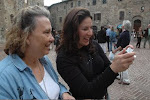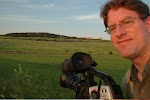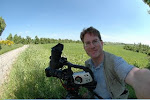Thank you for visiting my Italy blog, which contains travel tips, wine musings, lodging & restaurant reviews, armchair travel to some of Italy's best destinations, and some favorite recipes. Divertitevi!
Aglio e Scalogno

Aglio e Scalogno: Garlic and Shallots at the Christmas Market in Florence
Tuesday, October 27, 2009
Check out the new La Contadina website!
Monday, October 19, 2009
Day by Day, "My Private Italy" tour itinerary
Depart US/Fly overnight to Italy. Tour begins at Pisa airport, so you may fly either directly into Pisa, or fly to Rome and connect to Pisa by air or by train. At the Pisa airport, you will be met by "La Contadina" tour guide Marybeth (“Bettina” while in Italy) and by filmmaker Steve McCurdy. We will embark on our first adventure right from here by visiting the famed Leaning Tower of Pisa in the Piazza dei Miracoli, a UNESCO World Heritage Site.* From here, we will transfer to Lucca (greater Lucca area pop. 86,000; pop. within medieval walls 8,000) and our centrally-located, 4-star hotel. Time to settle in, stroll in the heart of this proud Etruscan city and enjoy a welcome dinner at one of Lucca’s finest restaurants. A mini language lesson for those interested.
Day 2
Breakfast and a quick morning stroll atop the ramparts to get our blood flowing before our drive to the ocean to visit the Cinque Terre, a string of 5 isolated, rugged villages clinging to the cliffs overlooking the Mediterranean. Let Steve show you some of his favorite spots he filmed for “My Private Italy,” as we search together for the best pesto, the most flavorful wine, lemon-flavored honey, local olive oil, and locally-made handicrafts in this UNESCO Natural World Heritage Park*. This is a day to admire the colorful architecture, breathe deeply of the sea air, and get some exercise as we climb and descend the often-steep and always-quaint village streets. Enjoy a little wine education courtesy of Bettina during dinner together on the coast before we return to our peaceful retreat in Lucca.
Day 3
Breakfast together and then off to Florence for the day! One could spend a whole week in Florence, or perhaps a lifetime, taking in the wonders of this world-famous city. It is not our intention to show you all of Florence but rather to expose you to the grandeur and magnificence of this cultural mecca, visiting some top spots along the way (incl. the Ponte Vecchio), to show you some hidden gems (good places to shop for leather, fun local trattoria for lunch together, best gelateria, etc.), and of course, to pose with the replica of Michelangelo’s David in the Piazza della Signoria. Dinner on your own tonight in Florence (we will happily make recommendations), and then we return to Lucca to pack our bags!
Day 4
This morning is our last breakfast in Lucca. We are going to get an early start so we can enjoy our drive through Tuscany and have time for a brief exploration of “San Gimignano delle belle Torri” (San Gimignano of the beautiful towers, pop. 7100), one of the best-preserved hill towns in all of Tuscany. In fact, San Gimignano has been made a UNESCO World Heritage Site* and still has 14 towers remaining from the 11th-13th centuries. We will wander the hilly streets and, for those up to the task, climb the 54-meter high Torre Grossa for an unparalleled view of the surrounding Tuscan countryside. Before taking off for Spoleto, Umbria, we will visit a famous gelateria (spring tour) and perhaps try the Crema di Santa Fina (orange cream gelato flavored with vanilla bean pods), or the famous Sorbetto alla Vernaccia, another specialty flavor found only here. You may want to pick up a bottle of local Vernaccia di San Gimignano, a lovely white wine made in this region since the Renaissance. We will then drive to Spoleto (pop. 36,000), check into our lovely centrally-located hotel, and call it a day – a great day!
Day 5
We get to sleep in a bit today! Breakfast at our hotel followed by an orientation to Spoleto and a free morning to do as you wish. You may cross the Ponte delle Torri (the Bridge of the Towers which began as a Roman aqueduct), or you may prefer to check out the Teatro Romano (Roman Theater) and the Casa Romana (Roman House). There are also plenty of shops in Spoleto selling lovely and affordable hand-painted ceramics, truffle oil, pasta, wine, and other souvenirs and gifts. Time for a nap in the early afternoon before we gather for our cooking class! Our renowned local chef will teach you to mix simple ingredients and create sophisticated dishes that will impress your friends and family. After our session in the kitchen we will relax and enjoy our scrumptious meal. We will stroll leisurely back to our hotel and enjoy sogni d’oro tonight (dreams of gold). Printed recipes will be emailed to you following the tour’s conclusion.
Day 6
For our last full day together, we will meet after breakfast for our day trip north to Bevagna (pop. 2,400) and Montefalco (pop. 5,500). These hilltop villages are lined with cobblestone streets and old shops. While in Bevagna we will visit a local winery for a wine tasting. On our way back, we will stop in Montefalco, and from the “Balcony of Umbria,” we will savor the panoramic views of the Umbrian hills and let the scenery gently revive our senses. After snacking on pizza we will shop for a wonderful local wine (Sagrantino di Montefalco or a Rosso di Montefalco) or other treasures. Back to Spoleto for our last dinner together and a night “passeggiata.”
Day 7
Arrivederci everyone! Transfer to Rome Fiumicino Airport and buon viaggio! For those of you extending your stay, you can ask to be transferred into the city from the airport. Thank you for traveling with us!
*UNESCO stands for the United Nations Educational, Scientific, and Cultural Organization. To learn more about UNESCO, please visit http://www.unesco.org/. Briefly (and taken from their website), UNESCO’s mission is “to contribute to the building of peace, the eradication of poverty, sustainable development and intercultural dialogue through education, the sciences, culture, communication and information.” A sub-mission of UNESCO is “to preserve humanity’s irreplaceable riches: its diversity and shared heritage.” To accomplish this, UNESCO catalogues, names, and conserves sites of outstanding cultural or natural importance to the common heritage of humanity. In particular, a World Heritage Site is a place of either cultural or physical significance and must be of "outstanding universal value." On our “My Private Italy” tour, we will visit 4 such sites: the Piazza del Duomo in Pisa, the Cinque Terre, the historic center of Florence, and San Gimignano.
Sunday, October 18, 2009
Cinque Terre, here we come!
 This is a great view of Riomaggiore, one of the 5 towns that make up the Cinque Terre on the Italian Riviera. UNESCO has proclaimed the area a Natural World Heritage Park.
This is a great view of Riomaggiore, one of the 5 towns that make up the Cinque Terre on the Italian Riviera. UNESCO has proclaimed the area a Natural World Heritage Park.These 5 towns (Monterosso al Mare {the largest}, Vernazza, Corniglia, Manarola, and Riomaggiore) cling to the cliffs above the Mediterranean, and boast quiet streets (no cars, no traffic), lots of shopping, and great pesto and seafood. We'll visit the Cinque Terre and see how many different pestos we can find, and who can find the best Cinque Terre wine! There are also lots of shops in Riomaggiore that sell olive oil and locally made handicrafts, and the famous "Via dell'Amore," or "Path of Love," is a short hiking trail joining Riomaggiore to the next village to the north, Manarola. You are sure to enjoy the tranquility and beauty of this excursion. 
Pesto Ingredients:
 Send your favorite pesto recipes to us at lacontadina@yahoo.com !
Send your favorite pesto recipes to us at lacontadina@yahoo.com !Saturday, October 17, 2009
Lucca, Tuscany - first stop on our "My Private Italy" tour!
 This is a view of the medieval walls and ramparts surrounding the lovely town of Lucca in northwestern Tuscany. Locals and tourists alike stroll atop these walls and even ride their bicycles up there for fabulous views. We stay in Lucca for 3 nights on the "My Private Italy" tour, using it as our home-base for exploring the Cinque Terre, Florence, nearby Tuscan hilltowns, and wineries.
This is a view of the medieval walls and ramparts surrounding the lovely town of Lucca in northwestern Tuscany. Locals and tourists alike stroll atop these walls and even ride their bicycles up there for fabulous views. We stay in Lucca for 3 nights on the "My Private Italy" tour, using it as our home-base for exploring the Cinque Terre, Florence, nearby Tuscan hilltowns, and wineries.
This is the facade of the Church of St. Michael (San Michele) in Lucca, Tuscany. The facade is reminiscent of the Cathedral of St. Martin (San Martino), a short distance away. Both facades feature columns that are all different from each other. Legend has it that the columns are different because, when the cathedral was under construction, the residents of Lucca held a contest to see which artist could make the most beautiful column. They couldn't decide and so used all of them to decorate the cathedral's facade. No matter whether the legend is true or not, both the church and the cathedral are breathtakingly beautiful. Our hotel, which is located at the geographic center of historic Lucca, is within easy walking distance to both these famous sites.
Friday, October 16, 2009
Choosing your squash blossoms for stuffing

This link is a great, short video explaining how to choose which squash blossoms to pick from your plant when you want to make stuffed squash blossoms. Many people don't realize that there are male and female blossoms on each plant, and because the females turn into your squash, you don't want to pick too many of the female blossoms. Watch this video to learn the difference!
And check back for a recipe for stuffed squash blossoms that I learned at a cooking class in Italy! The photo to the left shows me blowing the blossom open to prepare it for stuffing.
PS There is no difference in taste between the male and female blossoms.
Tuesday, October 6, 2009
New Press Release Issued!
My Private Italy tour dates announced!
Truffle Trivia, as promised!
OK, here is the truffle trivia, as promised! This information was provided to us in an unforgettable cooking class in Spoleto, Umbria, at Il Tartufo - meaning, "The Truffle."
- Store white truffles in damp towel, but store black truffles in dry towel.
- Always use white truffles fresh, never cooked (the heat of the dish will release the flavor), whereas black truffles are made into sauces and salsas - they are never shaved fresh or raw on top of a dish.
- There are two types of Black truffles - summer and winter varieties.
- What should you pay for truffles? White truffles cost about 180 Euro/kilo. Summer black truffles cost ~150 Euro/kilo, and winter black truffles can easily cost up to 1500 Euro/kilo !
- Other differences between summer and winter black truffles:
- The summer type is the "lesser" type and therefore costs much less; the winter type is called "pregiato," which meach appreciated or prestigious. It is the more precious of the two types of black truffles.
- Summer black truffles' surface is thick and abrasive/rough with bigger holes, whereas the winter black truffles' surface is smoother with tiny pores.
- You should clean the surface of black truffles with a little brush to remove the dirt (also makes them weigh less so you pay less!) allowing you to carefully examine the surface. It could save you a lot of money and help you not pay for winter truffles when they're trying to sell you summer truflles (if you happen to encounter an unscrupulous vendor).
- Summer black truffles are black on the outside but beige on the inside! Winter black truffles are actually black throughout, even a dark purplish black.
- Black truffles, both summer and winter, have veins running throughout. The summer truffles' veins are larger and fewer, whereas the winter truffles' veins are very thin and narrow.
Now, you are all prepared to shop for truffles! Buon appetito!
Don't Just Dream It - Do It ! Let us take you on a tour of a lifetime!
L to R: Marybeth, Giuliana (owner/founder) Steve (filmmaker)
La Contadina Travels and Tours, the company I work for
La Contadina ad on Slow Travel website
Giuliana, owner of La Contadina Travels and Tours

Giuliana, on the right, leading a tour in Umbria
Steven Robert McCurdy, documentary filmmaker and my fellow tour guide

Steve taking a self-portrait in Italy
Another self-portrait of Steve, who is co-leading the tour with me

Italian Club of Salt Lake
The ICSL also offers wonderful Italian language classes in a fun and comfortable setting at Raw Bean Cafe', at 611 South West Temple (great access off I-15). I'm the coordinator of the classes as well as a student, and believe me, the classes are great!